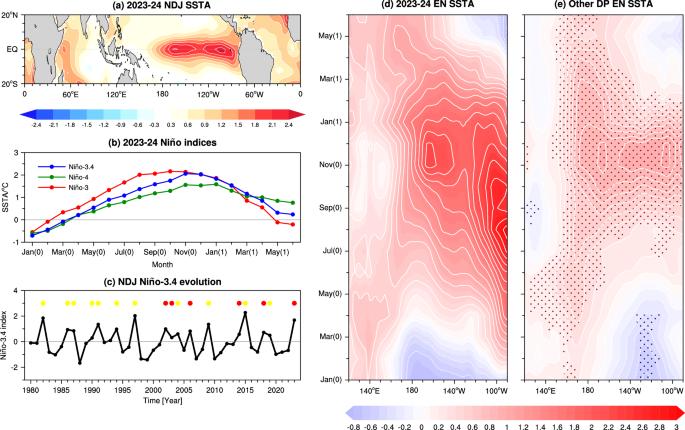On the spatial double peak of the 2023–2024 El Niño event
IF 8.1
1区 地球科学
Q1 ENVIRONMENTAL SCIENCES
引用次数: 0
Abstract
The 2023–2024 El Niño has raised widespread concern in scientific and public communities. Here, using latest observational reanalysis, we show that this event matured with two distinct spatial peaks of sea surface temperature anomaly in the equatorial central and eastern Pacific, respectively. Like other double-peaked El Niños, the central Pacific sea surface temperature peaked in winter due to zonal advective and thermocline feedbacks. However, the eastern counterpart matured asynchronously in autumn and then stopped growing. This peculiar behavior results primarily from a cooling zonal advection by the anomalous westward current in the eastern Pacific during the autumn of 2023, which is associated with the local wind-driven sea surface height meridional concavity. We further propose that the relatively stronger and more eastward-displaced autumn precipitation in the Pacific intertropical convergence zone in 2023, compared to other double-peaked El Niños, is the primary cause of this distinct wind and sea surface height pattern. The 2023–2024 El Niño experienced two distinct spatial peaks of sea surface temperature anomaly in the equatorial central and eastern Pacific, with the central Pacific peak occurring in winter due to zonal advection and thermocline feedback, while the eastern counterpart matured in autumn, according to results from observational reanalysis data.

关于 2023-2024 年厄尔尼诺现象的空间双峰现象
2023-2024 年的厄尔尼诺现象引起了科学界和公众的广泛关注。在此,我们利用最新的观测再分析结果表明,这次厄尔尼诺现象的成熟期在赤道中太平洋和东太平洋分别出现了两个明显的海面温度异常空间峰值。与其他双峰厄尔尼诺现象一样,太平洋中部海面温度峰值出现在冬季,这是由于地带平流和热层反馈作用所致。然而,与之对应的东部厄尔尼诺现象却在秋季不同步地成熟,然后停止增长。这种奇特的行为主要源于 2023 年秋季东太平洋异常西向洋流的冷却带平流,这与当地风力驱动的海面高度经向凹陷有关。我们进一步提出,与其他双峰厄尔尼诺现象相比,2023 年太平洋热带辐合带秋季降水相对较强,且更偏东,这是造成这种独特的风和海面高度模式的主要原因。根据观测再分析数据得出的结果,2023-2024 年的厄尔尼诺现象在赤道中太平洋和东太平洋出现了两个不同的海面温度异常空间峰值,其中太平洋中部的峰值出现在冬季,原因是地带性平流和温跃层反馈,而东部的峰值则在秋季成熟。
本文章由计算机程序翻译,如有差异,请以英文原文为准。
求助全文
约1分钟内获得全文
求助全文
来源期刊

Communications Earth & Environment
Earth and Planetary Sciences-General Earth and Planetary Sciences
CiteScore
8.60
自引率
2.50%
发文量
269
审稿时长
26 weeks
期刊介绍:
Communications Earth & Environment is an open access journal from Nature Portfolio publishing high-quality research, reviews and commentary in all areas of the Earth, environmental and planetary sciences. Research papers published by the journal represent significant advances that bring new insight to a specialized area in Earth science, planetary science or environmental science.
Communications Earth & Environment has a 2-year impact factor of 7.9 (2022 Journal Citation Reports®). Articles published in the journal in 2022 were downloaded 1,412,858 times. Median time from submission to the first editorial decision is 8 days.
 求助内容:
求助内容: 应助结果提醒方式:
应助结果提醒方式:


